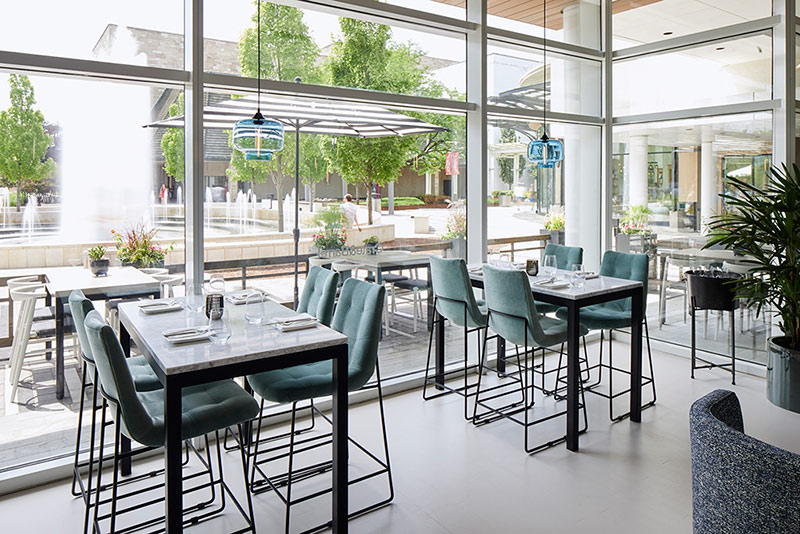零售发展新趋势:购物+餐饮

|
将餐厅与零售业结合起来的概念早已有之,但随着实体商店争相吸引日益疲惫而又时间紧迫的消费者,这个概念正在重新焕发活力。 “在零售空间内提供食物背后的理念是创造休憩空间感,毕竟体验是购物不可或缺的一部分。这是个可以放松身心、享受当下,并在零售环境中消磨时间的地方。”纽约零售和时尚行业咨询公司Doneger Group的时尚总监罗斯安娜·莫里森说道。 Crate & Barrel在奥克布鲁克购物中心开了一家名为The Table at Crate的餐厅,提供全方位服务;露露柠檬在芝加哥林肯公园社区开设了一家名为“燃料空间”的自助咖啡馆,位于其2万平方英尺(约合1858平方米)的体验店的二楼。到今年10月24日,诺德斯特龙将在纽约市哥伦布圆环开设第一家餐厅加酒吧旗舰店,届时,店内将推出六种不同的餐饮概念。以上都是新近迈入餐饮领域的零售商。 而在它们加入这场竞争之前,已经有众多老牌零售商拥有了自己的餐厅。比如:巴尼斯纽约精品店的Freds餐厅、萨克斯第五大道精品百货旗舰店的L’Avenue餐厅、旧金山尼曼·马库斯百货的Rotunda餐厅,以及波道夫·古德曼精品百货店的BG餐厅等。 除此之外,宜家也开设了著名的Bistro平价自助餐厅,提供免费咖啡以及瑞典肉丸之类的特色美食。 餐饮服务能带来更多顾客,还能增加人气 商店加餐饮的概念重新变得有吸引力,背后的原因似乎很简单——零售业正在挣扎求存,而餐饮业生意却很好。 弗雷斯特研究公司的零售业分析师苏查里塔·科达利表示, “过去20年,人们在外出就餐上的花费比在服装或其他任何实物上的花费都要多。” 此外,增加餐饮服务可能会对店内销售产生积极影响。 “这样可以实现不用的目标——便于外卖销售更多商品,也能够让驻足享受独特美食顾客获得丰富的就餐体验,等等。”科达利说道。 Crate & Barrel的首席执行官尼拉·蒙哥马利表示,整合餐饮服务对家居用品品牌来说是一种很自然的延伸。 “这样的尝试让人感到激动,我们相信零售和餐饮结合会有美好的前景。” 蒙哥马利说。“从空间利用的角度来看,我们确实看到了将类似概念引入其他商店的机会。虽然目前没有具体的计划,但我们一直都在探索新的方式,为顾客提供超越传统购物体验的有意义的时光。” 芝加哥知名餐厅Urban Belly的大厨比尔·金姆达以及餐饮集团Cornerstone Restaurant Group都与The Table at Crate达成了合作。餐厅提供午餐、下午茶和晚餐,菜品包括售价15美元的柑橘腌制冷熏三文鱼、15美元的西瓜沙拉、29美元的侧腹横肌牛排和15美元的 C&B汉堡包等。 蒙哥马利称,在店内提供食物和饮料是一种策略,加上商店本身的吸引力,就能够以一种有趣而轻松的方式吸引更多顾客。 “The Table at Crate不仅为我们的奥克布鲁克门店带来了客流量,还增加了顾客来店频率,并以真正忠于品牌的方式展示了我们在餐饮和娱乐空间的专业知识。” 蒙哥马利说道。 露露柠檬的“燃料空间” 在露露柠檬位于芝加哥北大道的第一家体验店里,购物者会发现除了该品牌著名的瑜伽裤,还有很多事情可以做。在“燃料空间”可以喝咖啡、品康普茶、享用午餐或晚餐,店内还提供两个健身房以及一个冥想室,每天都有瑜伽、力量训练和高强度间歇训练课程。 “林肯公园店体现了露露柠檬的宗旨、愿景和文化。”该公司的美洲和全球客源创新部门执行副总裁塞莱斯特·伯戈因说。“它专为我们的客人而打造,让他们能够在同一个空间内体验人际交往、融入社区和流汗的感觉。‘燃料空间’是我们的第一次尝试,除了可以促进与顾客的联系之外,它还提供来自于当地的季节性食物和饮料,以便客人在充分发挥自身潜力的同时,更好地放松身心。” 现在就断言露露柠檬是否会开设更多配备咖啡店的门店还为时尚早。 “能够了解更多关于‘燃料空间’、健身房和冥想空间如何与顾客产生共鸣的信息,这让我们感到很激动。” 伯戈因说,“目前我们专注于测试和学习,但考虑到不久的将来可能会开设其他体验店我们就感到激动。” 然而,餐饮行业并非没有挑战。 “像萨克斯第五大道和诺德斯特龙这样的百货商店都有一些餐厅,过去一直很有希望,但在餐饮业激烈的竞争下,如今的形势可能会变得艰难。” 科达利说道。“更好的方法是引入一种现有的概念,或是与一位知名大厨合作开一家店中店。Urban Outfitters就另辟蹊径直接收购意式餐饮集团Vetri。不能确定此举是否会改变品牌形象,但这的确是个好办法。” 创造出一个休憩空间并不困难,开设在纽约肉库区的爱马仕商店里的咖啡吧就是一个很好的例子。莫里森说道:“在安静平和的休憩空间里,购物者有可能获得愉悦购物体验,同时能够全身心地沉浸在品牌之中。”(财富中文网) 译者:艾伦 审校:夏林 |
Mixing restaurants with retailing is an old concept that's being reenergized as brick-and-mortar stores vie for attention from increasingly harried and time-challenged consumers. “The concept behind offering food within the retail space is a sense of dwell space where experience is integral to shopping. A place to relax, savor the moment, and linger in the retail environment,” said Roseanne Morrison, fashion director at Doneger Group, a New York-based consulting firm for the retail and fashion industries. The latest retailers to venture into the food arena for the first time are Crate & Barrel, opening The Table at Crate, a full-service restaurant, at Oakbrook Shopping Center, and Lululemon, debuting Fuel Space, a self-service café located on the second floor of its 20,000-square-foot experiential store, in Chicago’s Lincoln Park neighborhood. And when Nordstrom opens its first flagship store in New York City on Oct. 24 at Columbus Circle, the retailer will launch six different food and beverage concepts, ranging between restaurants and bars. These retailers join a list of stores offering well-established dining components—Freds at Barneys New York, L’Avenue at the Saks Fifth Avenue flagship, The Rotunda at Neiman Marcus in San Francisco, and BG, the restaurant at Bergdorf Goodman. At another end of the food-with-shopping spectrum, is Ikea's well-known, no-frills Bistro cafeteria, serving free coffee, along with specialties like Swedish meatballs. Dining adds customers and ambiance The renewed attraction to store dining seems straightforward—as retail struggles, restaurants are doing well. “People have been spending a lot more on eating out over the last 20 years than they have been on clothing or any other physical item,” said Sucharita Kodali, a retail analyst with Forrester Research. Plus, adding food service could have a positive impact on sales. “They can serve different purposes—additional SKUs for more takeout sales that are about convenience, sit down and unique menu items for more of a restaurant experience, etcetera,” Kodali said. Neela Montgomery, chief executive officer at Crate & Barrel, said incorporating food and beverage was a natural extension for the home furnishings brand. “We view this project as an exciting experimental moment and we truly believe in the combination of retail and dining,” Montgomery said. “Depending on how the space performs, we do see an opportunity to bring similar concepts to other stores. Though we don’t have concrete plans at this time, we’re always exploring new ways to offer meaningful moments to our customers beyond the traditional shopping experience.” The Table at Crate is a partnership with Chicago chef Bill Kim, of Urban Belly fame, and Cornerstone Restaurant Group. The restaurant offers lunch, afternoon tea, and dinner. Menu items include a Citrus Cured Cold Smoked Salmon, $15, Watermelon Salad, $15, Skirt Steak, $29, and C&B Burger, $15. Montgomery said offering food and beverage within stores is a strategy to engage retail customers in a fun, leisurely way beyond the store setting. “The Table at Crate is a way for us to not only drive traffic to our Oakbrook store, but also increase the frequency of customers visiting us, while showcasing our expertise in the dining and entertaining space in a way that’s truly authentic to the brand,” Montgomery said. Lululemon’s Fuel Space At Lululemon’s first experiential store, on North Avenue in Chicago, shoppers will find plenty to do beyond shopping for the brand’s famous yoga pants. In addition to grabbing coffee, a kombucha on tap, lunch or dinner at Fuel Space, the store offers two workout, or “sweat,” studios, with daily yoga, strength training and HIIT classes, and a meditation room. “Lincoln Park embodies Lululemon’s purpose, vision, and culture,” said Celeste Burgoyne, executive vice president, Americas and Global Guest Innovation. “The location was designed for our guests to experience connection, community, and sweat all under one roof. The Fuel Space is a first for us, and in addition to fostering connection, it offers locally-sourced, seasonal food and drinks so that our guests can connect with their bodies while living into their full potential.” It’s too early to say whether the brand will open more stores with cafés. “We’re really excited to learn more about how the Fuel Space, sweat studios, and meditation space resonate with our guests,” Burgoyne said. “Right now, we’re focused on testing and learning, but we’re excited to consider other experiential stores in the near future.” The food industry, however, is not without its challenges. “Department stores like Saks and Nordstrom have some restaurants and they have been promising in the past, but there is so much competition in food that it may be harder now,” Kodali said. “A better approach is to license an existing concept or have a store-in-store with an established chef. Urban Outfitters acquired Vetri outright so that’s another approach. Not sure it’s transformed the brand but it’s a fascinating idea.” Creating a dwell space can be simple and Morrison points to the coffee bar at the Hermes store in the Meatpacking District in New York as a good example. “It provides a quiet calm and an opportunity for enjoying the store experience, while immersing the shopper in the totality of the brand,” she said. |













